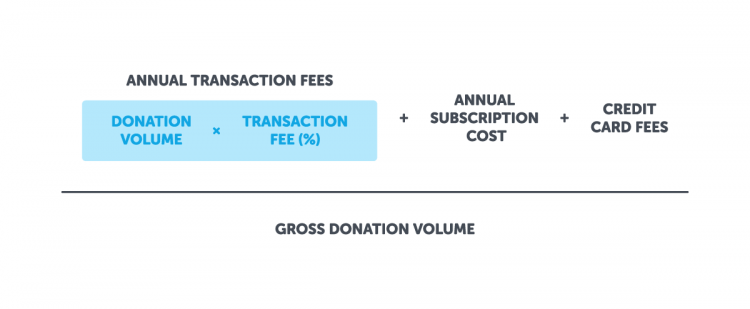What Is the Cost of Your Fundraising?

How much money do you spend on your entire fundraising operation? In order to truly grasp if your organization is making the traction necessary to see positive gains, you need to be able to answer this crucial question. If you end up spending more than $1 to raise $1, you’ll be spinning your wheels and slowly losing progress.
There are a plethora of minute details and costs that factor into your overall cost of fundraising (CoF), return on investment (ROI), and bottom line though. In addition, while there are some consistent factors from nonprofit to nonprofit, most are relative to each organization.
To help with your due diligence, we met with Classy’s former CFO and COO Ron Wangerin. Below, we’ll discuss a couple of the most visible costs you should be paying attention to, before moving into more nuanced factors to consider. Then, you’ll learn why it’s important to shift your focus from departmental budgets to full ROI in order to see the full picture of your fundraising costs.
Examining the Fees
When calculating the cost of online fundraising, almost all nonprofits look at subscription and transaction fees first. These are the fees associated with the platform, or platforms, used to run their digital fundraising operations.
The subscription fee—the monthly cost to license an online fundraising software—typically shows up as a line item in a departmental budget. Because these fees have high visibility on budgets, they’re often heavily scrutinized.
This is one of the main reasons nonprofits might be averse to paying high prices to use certain software platforms, opting instead for less expensive choices. However, that’s not always a financially sound plan because you still have to account for transaction fees.
Transaction fees are not as highly visible and usually don’t appear on budgets. Instead, they’re taken off the top of net revenue or net funds brought in.
This is an important distinction because in their search for platforms with low subscription fees, nonprofits might overlook how much they’re spending on transaction fees. In some cases, transaction fees can even become as expensive, or more expensive, than subscription fees. Further, you have to account for credit card fees associated with your payment processor, which can add additional expenses on top.
“When you look at nonprofits trying to get the lowest subscription price, many of them are focused on their departmental budget. They look at what they can spend in their budget line item instead of looking at the full picture of what their total fundraising costs may be.
These different fees are great examples of why it’s important to do your due diligence to get an accurate number for how much you’re spending.
Digging Into Your Details
In addition to subscription and transaction fees, your true cost of fundraising needs to account for everything that powers your operations, from marketing spend to staff salaries. This is where it becomes very specific to your organization’s operations.
There are countless nuances. When it comes to calculating your true cost of fundraising, it’s entirely subjective per organization.
Take your time and work to uncover the different factors that might contribute to your cost, such as:
- Salaries, benefits and overhead for your fundraising, IT, and accounting staff
- Time spent or external costs for creating fundraising pages
- Credit card fees
- Fundraising page upkeep costs
- Marketing costs, both direct and indirect
- Advertising (print and digital) spend to promote your campaigns
- The cost to work with outside organizations, like direct mail houses (mailing lists, printing and postage)
- Payments for content creators (copywriters, video producers, and designers)
- Cost to outsource or contract work, like coding or graphic design
- Physical cost for things like postage prices on direct mail
While most nonprofits operate, spend, and allocate resources differently from one another, there is one area that tends to be more objective in nature. Nonprofits that use an online fundraising platform like Classy can calculate the cost it takes to run their software.

Looking at the Big Picture
As Ron says, to accurately calculate the cost of online fundraising it’s important that nonprofits also examine the big picture beyond just the budget line items. In order to do this though, it requires a shift in mindset.
“Organizations are often worried about the cost of their fundraising platform. But what we’ve learned from our customers at Classy is that being on the wrong online fundraising platform often costs the nonprofit organization a multiple of the cost in potential lost revenue. So, while you might be worried about the $1,000 a month spent on fundraising software, you may very well be losing upwards of $50,000 or $100,000 in annual fundraising revenue because you’re on the wrong platform.
Keep your focus on the full ROI over the departmental budget by taking into account time, effort, and resources that contribute to the revenue generated from online fundraising. That includes things like conversion rates, the time-cost for staff to build campaigns, or trust you build with donors.
Conversion Rates
If you’re on an online fundraising platform where donors convert at 8% or 10%, you have to analyze how much that conversion rate costs. How much marketing spend are you using to drive traffic to the page in hopes people convert?
For example, if your current marketing efforts drive 1,000 pageviews to your campaign page that converts at 10%, you’re going to get 100 donations. However, if you double that conversion rate to 20% by allocating more marketing spend, you can raise more money, convert more donors, and get a higher ROI for your online software investment.
What’s more, that donor is now in your CRM. You can now work to nurture that relationship and turn a one-time donor into a recurring giver, peer-to-peer fundraiser, volunteer, or more: you can make them a lifelong supporter.
Time to Create
If you spend more money to use a well-designed online fundraising software, you might only need two staff members who can build mobile-optimized pages in 10 minutes. This not only lowers your operation costs, but also lowers your time investment into future fundraising campaigns.
This can also help when you need to be first-to-market with a campaign. For example, disaster relief nonprofits need to spin up pages the minute an event occurs, and if they’re not first or second they risk losing crucial donors.
Build Trust
The right fundraising software can also build trust with your donors which could, in turn, lead to large or more frequent donations.
Why America Gives, Classy’s report on consumer giving habits, revealed that 52% of consumers of all ages find it easiest to make donations digitally, whether on a computer or smartphone. What’s more, 49% said if it were easier or more convenient to donate to their favorite nonprofit, then they’d definitely or probably give more often.
From that same survey, 41% of total respondents said that if they can’t easily donate to a nonprofit online or via a mobile device, then they will have less trust in how an organization uses donated funds. If your solution isn’t up to consumer expectations and is turning donors away, you may be losing more that you would have gained by choosing a less sophisticated platform.
If you want to run a powerhouse online fundraising engine that nets your organization more revenue, you have to know how much you’re spending to power that engine. Without that knowledge, or without a complete picture, you likely won’t understand the full picture of your ROI.
As you go, don’t be afraid to invest in your technology stack if you want to scale your impact over time. Remember that it’s an investment that will reap larger rewards in the long haul. Focus on the ROI over the departmental budget if you can.
If you’re curious about how Classy might fit into your tech stack and help improve your ROI, schedule a chat with a team member below.

Talk to a Classy Expert



